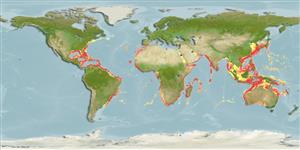Classification / Names
Common names from other countries
Main reference
Size / Weight / Age
Max length : 200 cm TL male/unsexed; (Ref. 10790); common length : 110 cm TL male/unsexed; (Ref. 3487); max. published weight: 68.0 kg (Ref. 7251); max. reported age: 15 years (Ref. 9739)
Length at first maturity
Lm ?, range 43 - ? cm
Environment
Marine; brackish; reef-associated; oceanodromous (Ref. 51243); depth range 0 - 1200 m (Ref. 9739)
Climate / Range
Subtropical; 17°C - 32°C (Ref. 12459), preferred 27°C (Ref. 107945); 47°N - 37°S, 98°W - 166°E (Ref. 12459)
Distribution
Worldwide in tropical and subtropical waters, but absent in the eastern Pacific (Ref. 9739, 33390) and the Pacific Plate, except marginally (Ref. 10948). Western Atlantic: Canada (Ref. 5951) to Bermuda and Massachusetts, USA to Argentina (Ref. 7251), including the Gulf of Mexico (Ref. 9626) and entire Caribbean (Ref. 26938). Eastern Atlantic: Morocco to South Africa. Indo-West Pacific: East Africa (Ref. 2871, 5213, 6644, 30573) and Hokkaido, Japan to Australia.
Countries | FAO areas | Ecosystems | Occurrences | Introductions
Short description
Dorsal
spines
(total): 7 - 9;
Dorsal
soft rays
(total): 26-33;
Anal
spines: 2-3;
Anal
soft rays: 22 - 28. Head broad and depressed. First dorsal fin with short but strong isolated spines, not connected by a membrane. Caudal fin lunate in adults, upper lobe longer than lower. Back and sides dark brown, with 2 sharply defined narrow silvery bands.
IUCN Red List Status (Ref. 115185)
Threat to humans
Harmless
Human uses
Fisheries: minor commercial; aquaculture: commercial; gamefish: yes
Tools
Special reports
Download XML
Internet sources
Estimates of some properties based on models
Phylogenetic diversity index
PD50 = 1.5000 many relatives (e.g. carps) 0.5 - 2.0 few relatives (e.g. lungfishes)
Trophic Level
4.0 ±0.0 se; Based on diet studies.
Resilience
Low, minimum population doubling time 4.5 - 14 years (K=0.09-0.22; tm=2-3; tmax=15)
Vulnerability
Moderate vulnerability (44 of 100)
Price category
